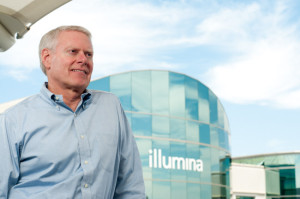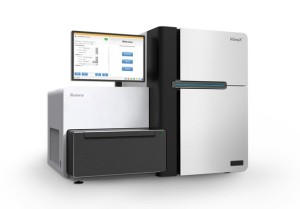This price includes all costs except overhead, but without a high volume of customers, Illumina’s $10-million price for the HiSeq X Ten machine may not be a wise investment
Competition continues to be fierce in the race to the $1,000 whole human genome. Most recently, Illumina announced the availability of its latest gene sequencing system, along with the claim that it can deliver a whole human genome at a cost of just $1,000. But, as most pathologists know, the devil is in the details, since not every Illumina customer is likely to achieve that price point.
When Illumina, a San Diego-based technology company, announced its new HiSeq X Ten genetic-sequencing machine in December, 2013, Illumina CEO Jay T. Flatley claimed the company’s system can deliver “full-coverage human genome sequences for less than $1,000,” down from $500 million 10 years ago. The new system is expected to ship in the first quarter of 2014.

Jay T. Flatley (pictured) is CEO of Illumina. He recently announced the company’s second-generation human genome sequencing technology, the HiSeq X Ten, at a healthcare investor’s conference in San Diego. Flately claimed the new gene sequencing system can deliver a human genome for under $1,000. (Photo by Sam Hodgson and copyright Voice of San Diego.)
Two of Illumina’s main competitors are Life Technologies in Carlsbad, California, and United Kingdom-based Oxford Nanopore. Each has made the same $1,000 claim about their gene-sequencing technologies, but have not yet actually achieved this milestone, according to some experts.
Chinese Company Acquired Complete Genomics in 2013
Another credible competitor is the Chinese sequencing powerhouse BGI-Shenzhen acquired Mountain, California-based Complete Genomics last year for $117 million and said it wanted to position itself as “the” global sequencing outsourcing provider.
A report published by Nature.com analyzed Illumina’s claim. The reporter concluded that the HiSeq X Ten may not be able to immediately provide human genome sequences for under $1,000, but will certainly come close. As described by Illumina’s Flatley, the breakdown of projected sequencing costs per genome includes $797 for reagents needed to run the machine, $137 for machine depreciation, and $55-$65 for technicians to run the machine and prepare samples for sequencing. It didn’t, however, include overhead costs, such as electricity to run the machine.
Racing to Achieve the $1,000 Whole Human Genome
“Some genomics researchers put the $1,000 genome on the same par as development of the telescope or microprocessor,” stated Michael Schatz, a quantitative biologist and Assistant Professor at Cold Spring Harbor Laboratory in New York, in a story published by Nature.com. “It there was any doubt to if genomics would ever be able to reach the everyday man, at this price point of efficiencies it is absolute certainty,” he added.
But the “fly in the ointment” is that relatively few healthcare facilities have the large volume of genetic samples to sequence that generate the economies of scale that would result in a $1,000 genome when using the HiSeq X Ten, which sells for $10 million. That limits the number of organizations who may have the volume to achieve the $1,000 price point. “It’s a good deal if you can play in this game,” observed Chad Nusbaum, Program Co-director of Broad Institute of Harvard University and Massachusetts Institute of Technology.
“It’s like the high-stakes poker game: if you’re playing $200 a chip, people who can’t afford those chips don’t care,” added Nusbaum. The Broad Institute is one of the world’s genome-sequencing heavyweights and already has a HiSeq X Ten on order.
Who is Likely to Benefit from Illumina’s HiSeq X Ten?
This gene sequencing equipment may turn out to be a reasonable investment for facilities that have already jumped into the genome sequencing marketplace, such as Partners HealthCare, Geisinger Health System, Scripps Health, and Medical College of Wisconsin. These facilities currently charge between $5,000 and $9,000 for a single human genome sequence, according to a report published by Modern Healthcare. (See Dark Daily, “Major Healthcare Systems Begin Building In-House Whole Human Genome Sequencing Capabilities, Creating New Opportunities for Pathologists,” February 4, 2014.)
Additionally, a study released last year by UnitedHealth Group (UNH: NYSE) estimated that U.S. spending on genetic testing may grow to between $15 billion and $25 billion annually by 2021.

Illumina’s HiSeq X Ten (pictured) is able to deliver a $1,000 human genome because it processing capabilities, with a well-ordered array of “nanowells” housing millions upon billions of individual DNA templates, enables it to read more data out per run. (Photo copyright Illumina.)
The HiSeq X Ten is capable of producing up to 1.8 terabases of data, or 16 human genomes, per three-day run, according to a report published by Nature.com. That gives it the capability to sequence 18,000 human genomes per year.
Medical laboratory professionals and pathologists should consider how Illumina’s latest generation of gene sequencing systems is intended to be a game changer. Claims of the $1,000 genome are evidence that the cost of gene sequencing continues to fall at a steady pace, even as the speed and accuracy of these systems improves.
—Patricia Kirk
Related Information:



